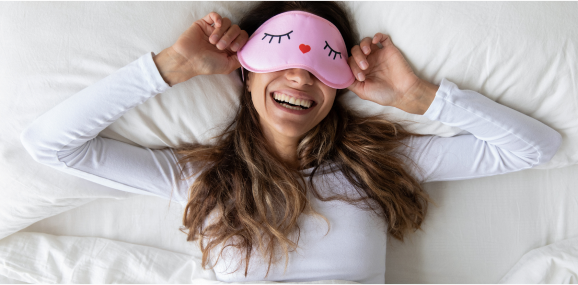Your body is exhausted, and your mind is tired. You’re settling into bed and on the verge of falling asleep… when suddenly you’re awakened by a jerk or twitch-like muscle spasm.
You’ve just experienced a hypnic jerk, a completely normal part of virtually everyone’s sleep cycles. Most of the time, hypnic jerks don’t cause too many problems, though they can be a bit unsettling. But if you’re already experiencing a lack of sleep, they can make it harder for you to rest.
Fear not! The team at Hug Sleep is here to help. We’ll explain what these strange muscle movements are, whether or not they’re dangerous, and how to prevent them.
What Is a Hypnic Jerk?
A hypnagogic jerk, or hypnic jerk, is a type of myoclonus, which is a muscle jerk or twitch that happens involuntarily. You experience these often when you are awake, such as when you have the hiccups or an eye twitch.
Involuntary muscle twitches are common, and they’re normally not cause for alarm. Hypnic jerks happen during the transition between being awake and falling asleep.
What’s Happening In Your Body
Hypnic jerks are movements that happen when your body is in the process of falling asleep. For that reason, they’re sometimes referred to as sleep starts and can even wake you from light sleep.
Are Hypnic Jerks Painful?
Most people don't experience any pain with a hypnic jerk. In fact, many people won’t even wake up when they have them.
If you sleep alone, you may not be aware that you’ve experienced a hypnic jerk. If you sleep with a partner, though, they might let you know your erratic twitching woke them up!
Sometimes, hypnic jerks are accompanied by dreamlike experiences that can include a falling sensation or seeing bright or flashing lights. Usually, only one side of the body is affected, but some people experience hypnic jerks in sequences that can affect both sides.
Who Is at Risk of Getting Hypnic Jerks?
Anyone can get hypnic jerks, but adults are usually more prone to them. Although there’s no clearly defined reason for why these types of muscle twitches happen, many of the likely causes are more common in adulthood.
What Causes Hypnic Jerks?
Overall, researchers aren’t 100% sure what makes us have a hypnic jerk, but they do have some theories. Hypnic jerks happen because of a sort of “misfire” in the part of the brain that controls your startle response — your sympathetic nervous system. When this area of the brain is stimulated once sleep has begun, misfires result in muscle twitches.
So what’s causing the misfire? There are a few possible causes.
1. Caffeine/Stimulants
One of the most likely causes of hypnic jerks is caffeine. Caffeine has a half-life of about five hours, which means that half of the stimulant is still in your bloodstream five hours after you’ve consumed it. Depending on what time you drank your coffee or energy drink, that lingering caffeine may waken your brain and prevent you from getting rest.
This type of stimulation can also alert your central nervous system and potentially cause a hypnic jerk.
2. Exercise Before Bed
Exercise is important for every system in your body, including your sleep. However, engaging in vigorous exercise before you hit the sack will keep your body more energized and your brain more stimulated, making you feel alert.
If possible, try to finish any evening exercise at least an hour and a half before you go to bed. If you can’t fit it in any other time, opt for exercise that’s less high-impact, like yoga or walking, rather than high-intensity cardio workouts.
3. Sleep Deprivation
Routinely missing out on needed sleep can place you at higher risk of experiencing hypnic jerks. This is because of your sleep cycle. Your sleep cycle consists of four discrete stages:
- Non-REM Stage 1
- Non-REM Stage 2
- Non-REM Stage 3
- REM (rapid eye movement) Stage 4
Hypnic jerks happen when you are transitioning between NREM Stage 1 to NREM Stage 2 sleep. If you are routinely missing sleep, your body will naturally have a harder time reaching later stages of sleep, which means you’ll likely experience more hypnic jerks.
Your body needs all four stages of sleep to get the adequate rest you need. Insomnia, whether acute or chronic, and other sleep disorders can cause your body to stay in the early stages of sleep too long.
4. Stress
It goes without saying that stress makes it harder to sleep. Elevated heart rate, feelings of worry, and even nervousness can all make it impossible for you to get the sleep you need. Feelings of stress are controlled by the sympathetic nervous system, which also triggers the release of the hormone cortisol.
Some medications prescribed to help deal with stress may also increase your likelihood of experiencing hypnic jerks. Talk to your healthcare provider about whether or not your medication may carry this risk.
Are Hypnic Jerks Dangerous?
Although they can be annoying, hypnic jerks aren’t dangerous. They can make it difficult to get a good night’s sleep, but they’re overall harmless and considered a normal part of the entire sleep process.
If, however, you experience these types of jerks or muscle contractions during the day when you are awake, you may be experiencing a different type of myoclonic jerk.
Most of the time, involuntary muscle twitching is a normal part of life, but if it bothers you or becomes persistent, it could be related to an underlying health condition like epilepsy.
Putting the Brakes on Hypnic Jerks
Even though they’re harmless, hypnic jerks can interfere with your sleep and become a nuisance. If they bother you and disrupt your sleep, there are steps you can take to experience fewer jarring jerks and twitches.
Limit Caffeine Intake
Limiting the amount of caffeine you consume can be hard, especially if you aren’t sleeping at night. But caffeine can become a vicious cycle. Drinking too much caffeine during the day will interfere with your sleep at night, requiring you to need more caffeine during the day to stay alert.
Additionally, caffeine can seriously increase the amount of hypnic jerks you experience. To avoid sleeplessness and jerks, limit your caffeine to one or two cups per day, and make sure you drink your last cup early enough in the day so that it doesn’t interfere with your sleep at night. A good rule of thumb is to drink your last caffeinated beverage at least six hours before bed.
Avoid Alcohol
A nightcap can seem like the perfect remedy, especially if you’re under a lot of stress. However, although alcohol may help you fall asleep, it generally interferes with your sleep cycle and makes it difficult for your body to transition through all four stages of sleep.
Drinking alcohol before bed can cause your body to stay in stages 1 and 2, where hypnic jerks are most common.
Stop Smoking
Nicotine is a stimulant, so it naturally doesn’t do you any favors when you’re attempting to sleep. If you’re experiencing hypnic jerks, smoking could be the culprit.
Improve Your Sleep Habits
Good sleep habits, or sleep hygiene, are the practices and exercises you engage in to help prepare yourself for successful sleep. Improving your sleep habits can help you avoid hypnic jerks and transition more smoothly between all stages of sleep.
You can improve your sleep habits by:
- Going to bed and waking up at the same time each day.
- Turning off blue-light emitting stimuli, like your phone or TV, at least an hour before you need to sleep.
- Creating a sleep-positive space in your bedroom that is dark, quiet, and cool.
- Engaging in deep breathing exercises, meditation, or other relaxation techniques before you hit the sack.
Small steps like these can increase your body’s ability to rest and transition into deeper sleep cycles.
Manage Your Stress
Stress isn’t always bad, but long-term stressors can have devastating effects on our health and ruin our chances of getting good, deep sleep. To understand why stress is so detrimental to our sleep, we first have to understand the two parts of the nervous system that help us transition from awake to relaxed.
- Sympathetic nervous system. Your sympathetic nervous system, or SNS, is the part of your brain that controls sleep jerks. It also controls your fight or flight response, and it triggers the release of hormones like cortisol that can keep you feeling on edge.
- Parasympathetic nervous system. The parasympathetic nervous system, or PSNS, does the opposite of the SNS. It helps transition you into a state of “rest and digest.” When the PSNS takes over, your body experiences physical changes like muscle relaxation, a lower heart rate, and the release of feel-good hormones like serotonin and dopamine.
Sometimes, these two systems don’t work properly. Instead of slowing to a halt at the end of the day, the SNS may ramp up, making it hard for the PSNS to relax you and prepare you for a peaceful, non-twitchy rest.
Thankfully, there’s a way to hack the system.
Deep Touch Pressure Therapy
Deep Touch Pressure Therapy, or DTPT, is a technique that uses deep, massage-like touch to stimulate the parasympathetic nervous system. By stimulating sensory receptors on your skin, DTPT can help you transition out of the hyper-alert feelings triggered by your SNS and relax into the restful feelings of the PSNS.
The best part? You don’t even need a massage, just a really great blanket.
The Hug Sleep Sleep Pod
Designed to provide the gentle touch therapy that stimulates your PSNS response, the Hug Sleep Sleep Pod offers a cocooning sensory experience that most people find incredibly comforting. Lightweight, breathable, four-way stretch fabric offers gentle compression on your entire body, similar to being hugged tightly.
Unlike a weighted blanket or vest, the Sleep Pod is virtually weightless. It also allows for total mobility, including an option with freedom for wiggly feet. Wearing the Sleep Pod can help your body transition to rest more seamlessly, which can in turn quiet the part of your brain responsible for producing hypnic jerks.
Rest can be difficult, and hypnic jerks can make it hard for you to fall asleep and stay asleep. The Sleep Pod helps give your body the deep touch pressure stimulation you need to drift off into restful, restorative slumber.
Sources:
What Does It Mean if You Experience Hypnic Jerks? | Sleep Foundation
Startle Response | Hilary King, MSTAT
The Best Time of Day To Exercise for Sleep | Sleep Foundation

































500,000+ happy customers